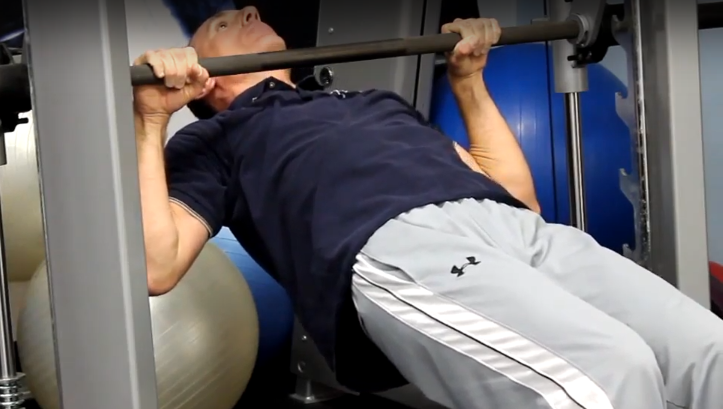Strengthen your midback, shoulders and arms with inverted rows.
Inverted rows, also known as supine pull-ups, are a body weight exercise that strengthens the muscles that pull the shoulder blades together. Much like vertical chin-ups and pull-ups, inverted rows develop back, shoulder, upper arm and forearm strength. The horizontal body position utilized in inverted rows directly targets the scapular retractor muscles.
Anatomy: The shoulder blades are named the scapulae in medical terminology. Several muscles contract to pull the shoulder blades toward the spine and toward each other. This motion is named scapular retraction.
Scapular retraction is performed during a positive contraction of the following muscles: rhomboid major, rhomboid minor and the middle and lower portions of the trapezius.
Physiology: Strong scapular retractors are required for correct shoulder function. Powerful scapular retractors counter balance the strong muscles which pull the shoulders forward. Proper strength balance between the scapular retractors and the anterior shoulder muscles lowers the risk of shoulder injury.
Training: Inverted rows are a viable substitute for barbell rows, dumbbell rows, seated pulley rows and T-bar rows. Inverted rows may be performed in conjunction with other bodyweight exercises, other back strengthening exercises or by themselves. Inverted rows can be executed on a Pilates Cadillac, with TRX cables, a Smith machine or on a make-shift apparatus strong enough to support your weight. In most gyms you can place a barbell inside a squat rack for inverted rows.
Multiple hand grip widths, hand grip positions and leg positions should be used. Each variation targets the muscles at a slightly different angle. Hand grip widths can be wide, medium or narrow.
Hand Grip Variations: Three possible hand grip positions exist: The palms-up position is called supination or underhand. It is the identical hand position used in chin-ups. While lying supine your palms will face the direction of your head. The supinated position is best utilized with a shoulder-wide or narrower hand position. Besides targeting the scapular retractors, the supinated hand position places a direct workload on the bicep muscles.
The palms-down position is called pronation or overhand. It is the exact hand grip used in pull-ups. While lying supine your palms face the direction of your feet. The pronated position is best utilized with a shoulder-width or slightly wider than shoulder-width hand position. The pronated hand position places a direct workload on the arm muscles called the brachialis and brachioradialis.
The palms facing each other position is called a neutral grip. While lying supine your palms facing each other and your thumbs face the direction of your head. It is the identical hand position used in hammer curls. The palms are halfway between supinated and pronated, hence the term neutral grip is applied.
A neutral grip is used when performing inverted rows on the Pilates Cadillac and when using TRX cables. A sturdy triceps bar can be placed in a squat rack for neutral grip utilization. The Pilates Cadillac is wider than shoulder width. The TRX neutral grip is shoulder width or narrower while the triceps bar grip can be shoulder width or slightly wider or slightly narrower.
Leg Position: Numerous leg positions exist: Legs straight with heels on the floor, legs straight with heels on a raised platform, knees bent with feet on the floor and knees bent with feet on a raised platform. The bent knee position is easier than the straight knee position. Beginners should start in the knees bent, feet on the floor position. Using a raised platform increases the intensity of inverted rows.
No matter which leg position you utilize flawless technique is imperative. The body should be in a straight line. The neck, spine, hips and thighs should line up perfectly. Hold an inverted plank position to maintain the spine, hips and thighs in a straight line. Holding an inverted plank requires core strength and endurance.
Technique: After determining the exact hand grip, grip width and leg positions you are ready to begin. Inhale, keep your body straight and slowly lowering yourself until your arms are straight. This is the starting position.
Exhale and retract your shoulder blades together as you pull yourself toward the bar. Next, pull with your back, shoulders and arms to bring the lower aspect of your chest toward the bar.
It is easier to learn proper technique in two steps:
Step One: Bring your shoulder blades together to ensure the muscles which retract the shoulder blades are the primary working muscles.
Step Two: Pull your chest toward the bar. The arms, shoulders and back muscles will be targeted.
Inhale and lower yourself in the exact two step manner. Graduate to one fluid motion, once you’re confident your technique is perfect.
Technique finer points:
Maintain your body in a straight line.
Keep your neck in line with your spine by not pulling your head forward when straining.
Keep your hips level. Do not let your hips drop down.
Pull the lower part of your chest to the bar.
Straighten your arms completely at the bottom.
Exhale when pulling yourself up.
Inhale when lowering yourself.
If holding your elbows at a ninety degree angle elicited shoulder pain then keep your elbows close to your body.
Begin the pulling motion with your scapula retractors. First and foremost inverted rows are a back strengthening exercise. Focus your energy on targeting the muscles which bring the shoulder blades together.
Start at a level that is appropriate for you and increase intensity gradually.
Inverted rows are an outstanding bodyweight exercise. Utilize inverted rows to strengthen your back, shoulders and arms. Improve your posture, increase shoulder function and build a powerful back with inverted rows.
Dr Donald A Ozello DC of Championship Chiropractic in Las Vegas, NV
Web Site: http://www.championshipchiropractic.com/
Blog: https://www.championshipchiropractic.com/wordpress/
YouTube: https://www.youtube.com/user/drdozellodc/videos
Twitter: https://twitter.com/drdozellodc
Facebook: https://www.facebook.com/Championship-Chiropractic-280141628688300/
LinkedIn: https://www.linkedin.com/in/dr-donald-a-ozello-dc-716b3233
“Running: Maximize Performance & Minimize Injuries” https://www.amazon.com/Running-Performance-Chiropractors-Minimizing-Potential/dp/1493618741
**Disclaimer: Always consult a medical professional before beginning an exercise program. Always work within your capabilities. Never perform an exercise that elicits or increases pain or symptoms. Reading this article and viewing the linked videos does not take the place of seeing a medical professional. Please visit a medical professional for evaluation, diagnosis & treatment.

